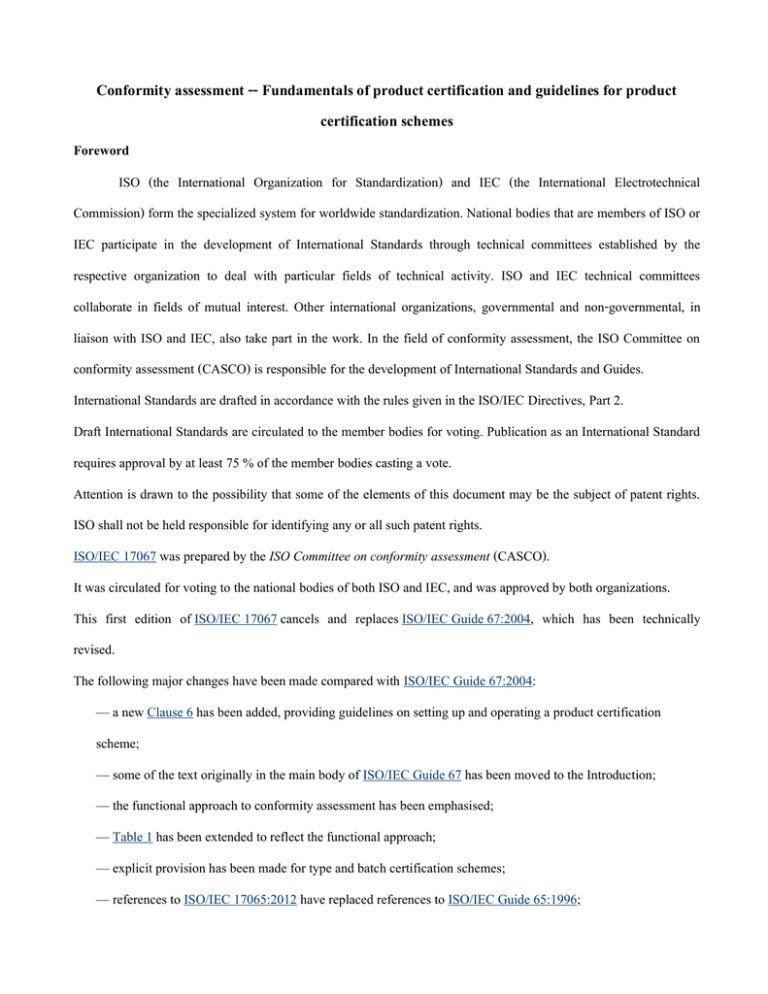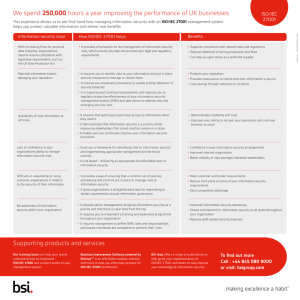
Conformity assessment -- Fundamentals of product certification and guidelines for product
certification schemes
Foreword
ISO (the International Organization for Standardization) and IEC (the International Electrotechnical
Commission) form the specialized system for worldwide standardization. National bodies that are members of ISO or
IEC participate in the development of International Standards through technical committees established by the
respective organization to deal with particular fields of technical activity. ISO and IEC technical committees
collaborate in fields of mutual interest. Other international organizations, governmental and non-governmental, in
liaison with ISO and IEC, also take part in the work. In the field of conformity assessment, the ISO Committee on
conformity assessment (CASCO) is responsible for the development of International Standards and Guides.
International Standards are drafted in accordance with the rules given in the ISO/IEC Directives, Part 2.
Draft International Standards are circulated to the member bodies for voting. Publication as an International Standard
requires approval by at least 75 % of the member bodies casting a vote.
Attention is drawn to the possibility that some of the elements of this document may be the subject of patent rights.
ISO shall not be held responsible for identifying any or all such patent rights.
ISO/IEC 17067 was prepared by the ISO Committee on conformity assessment (CASCO).
It was circulated for voting to the national bodies of both ISO and IEC, and was approved by both organizations.
This first edition of ISO/IEC 17067 cancels and replaces ISO/IEC Guide 67:2004, which has been technically
revised.
The following major changes have been made compared with ISO/IEC Guide 67:2004:
— a new Clause 6 has been added, providing guidelines on setting up and operating a product certification
scheme;
— some of the text originally in the main body of ISO/IEC Guide 67 has been moved to the Introduction;
— the functional approach to conformity assessment has been emphasised;
— Table 1 has been extended to reflect the functional approach;
— explicit provision has been made for type and batch certification schemes;
— references to ISO/IEC 17065:2012 have replaced references to ISO/IEC Guide 65:1996;
— the text has been made more concise in places.
Introduction
This International Standard describes the fundamentals of product certification and provides guidelines for
product certification schemes. In this International Standard references to the term “product” can also be read to mean
“services” or “processes”.
As products are designed, produced, distributed, used and ultimately disposed of, they can give rise to concerns with
purchasers, users and society in general. Such concerns could relate to safety, health or environmental impacts,
durability, compatibility, suitability for intended purposes or for stated conditions.
Generally, these concerns are addressed by specifying the required product attributes in a normative document such
as a standard.
The supplier of the product then has the task of demonstrating that the product conforms to the requirements of the
normative document.
It might be sufficient for the supplier to assess and declare its product's conformity, but in other cases the user or a
regulatory authority might require that conformity be assessed by a competent and impartial third party.
Assessment and impartial third party attestation that fulfilment of specified requirements has been demonstrated for
the product is referred to as product certification.
This International Standard outlines how schemes for product certification can be structured and managed. It
identifies common assessment techniques that are used as a basis for product certification, such as product testing,
inspection and auditing.
This International Standard is intended for use by those involved with product certification, particularly those who
are, or who are considering becoming, product certification scheme owners. Product certification scheme owners can
include:
a) product certification bodies;
b) government and regulators;
c) purchasing agencies;
d) non-government organizations;
e) industry and retail associations; and
f) consumer organizations.
This International Standard provides only guidance and does not contain requirements. It is compatible
with ISO/IEC 17065, which specifies requirements for product certification bodies.
In this International Standard, the following verbal forms are used:
— “should” indicates a recommendation;
— “may” indicates a permission;
— “can” indicates a possibility or a capability.
The modal verb "shall", which indicates a requirement, is not used because this International Standard only provides
guidelines.
Further details can be found in the ISO/IEC Directives, Part 2.
1 Scope
This International Standard describes the fundamentals of product certification and provides guidelines for
understanding, developing, operating or maintaining certification schemes for products, processes and services.
It is intended for use by all with an interest in product certification, and especially by certification scheme owners.
NOTE 1 In this International Standard the term “product” can also be read as “process” or “service”, except in those
instances where separate provisions are stated for “processes” or “services”. Definitions of product, process and
service are given in ISO/IEC 17065.
NOTE 2 The certification of products, processes and services is a third-party conformity assessment activity
(see ISO/IEC 17000) carried out by product certification bodies. The requirements for product certification bodies are
specified in ISO/IEC 17065.
2 Normative references
The following referenced documents are indispensable for the application of this document. For dated references,
only the edition cited applies. For undated references, the latest edition of the referenced document (including any
amendments) applies.
ISO/IEC 17000:2004, Conformity assessment — Vocabulary and general principles
ISO/IEC 17065:2012, Conformity assessment — Requirements for bodies certifying products, processes and
services
3 Terms and definitions
For the purposes of this document, the terms and definitions given in ISO/IEC 17000, ISO/IEC 17065 and the
following apply.
3.1
certification system
rules, procedures and management for carrying out certification
[SOURCE: ISO/IEC 17000:2004, 2.7, modified]
3.2
certification scheme
certification system (3.1) related to specified products, to which the same specified requirements, specific rules and
procedures apply
Note 1 to entry: The rules, procedures and management for implementing product, process and service certification
are stipulated by the certification scheme.
[SOURCE: ISO/IEC 17065:2012, 3.9, modified]
3.3
scheme owner
person or organization responsible for developing and maintaining a specific certification scheme (3.2)
Note 1 to entry: The scheme owner can be the certification body itself, a governmental authority, a trade association,
a group of certification bodies or others.
[SOURCE: ISO/IEC 17065:2012, 3.11]
Bibliography
[1] ISO 2859-10, Sampling procedures for inspection by attributes — Part 10: Introduction to the ISO 2859 series
of standards for sampling for inspection by attributes
[2] ISO 3951-1, Sampling procedures for inspection by variables — Part 1: Specification for single sampling plans
indexed by acceptance quality limit (AQL) for lot-by-lot inspection for a single quality characteristic and a
single AQL
[3] ISO 10576-1, Statistical methods — Guidelines for the evaluation of conformity with specified requirements —
Part 1: General principles
[4] ISO/IEC 17007, Conformity assessment — Guidance for drafting normative documents suitable for use for
conformity assessment
[5] ISO/IEC 17020, Conformity assessment — Requirements for the operation of various types of bodies
performing inspection
[6] ISO/IEC 17021 (all parts), Conformity assessment — Requirements for bodies providing audit and certification
of management systems
[7] ISO/IEC 17025, General requirements for the competence of testing and calibration laboratories
[8] ISO/IEC 17030, Conformity assessment — General requirements for third-party marks of conformity
[9] ISO 22514-1, Statistical methods in process management — Capability and performance — Part 1: General
principles and concepts
[10] ISO 31000, Risk management — Principles and guidelines
[11] ISO Guide 27:1983, Guidelines for corrective action to be taken by a certification body in the event of misuse of
its mark of conformity
[12] ISO/IEC Guide 28:2004, Conformity assessment — Guidance on a third-party certification system for products
[13] ISO/IEC Guide 53, Conformity assessment — Guidance on the use of an organization's quality management
system in product certification
[14] ISO/IEC Guide 68, Arrangements for the recognition and acceptance of conformity assessment results
© 2013 ISO/IEC — All rights reserved
ที่มา : https://www.iso.org/obp/ui/#iso:std:iso-iec:17067:ed-1:v1:en






